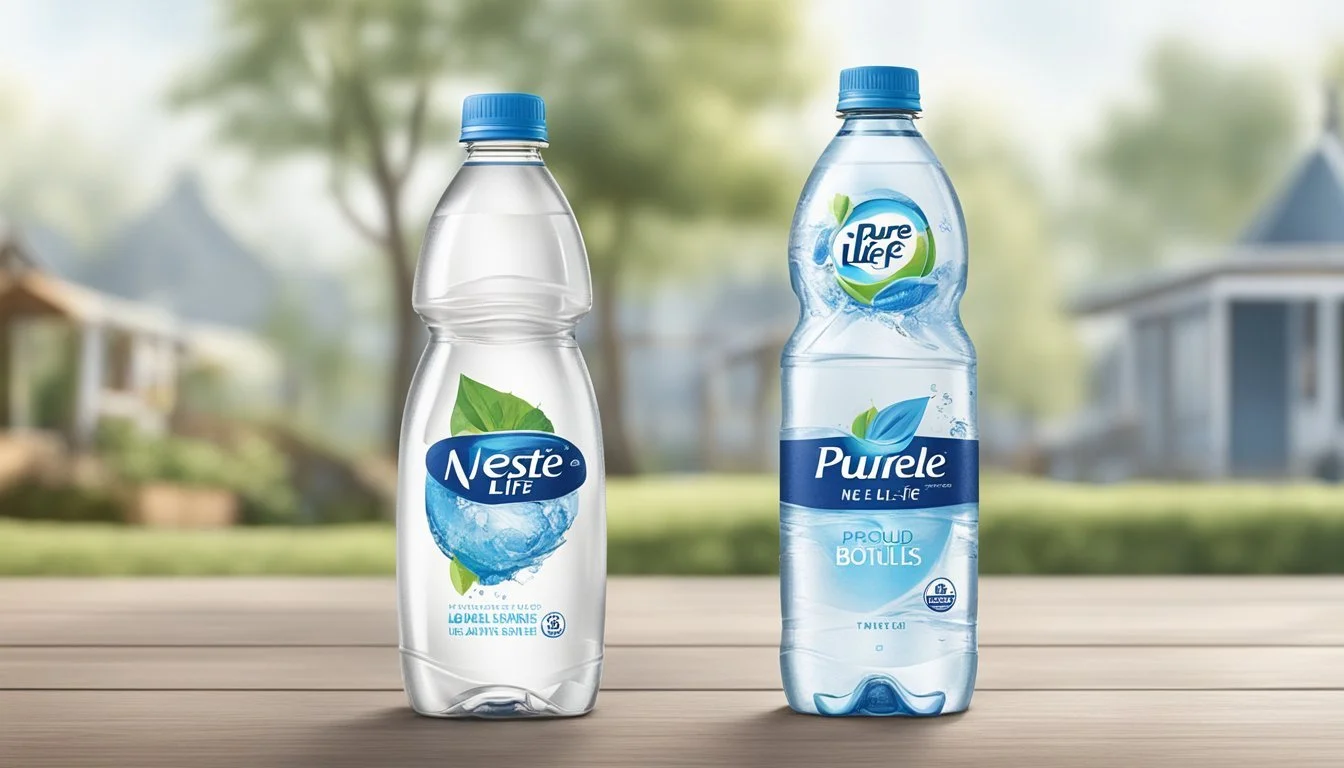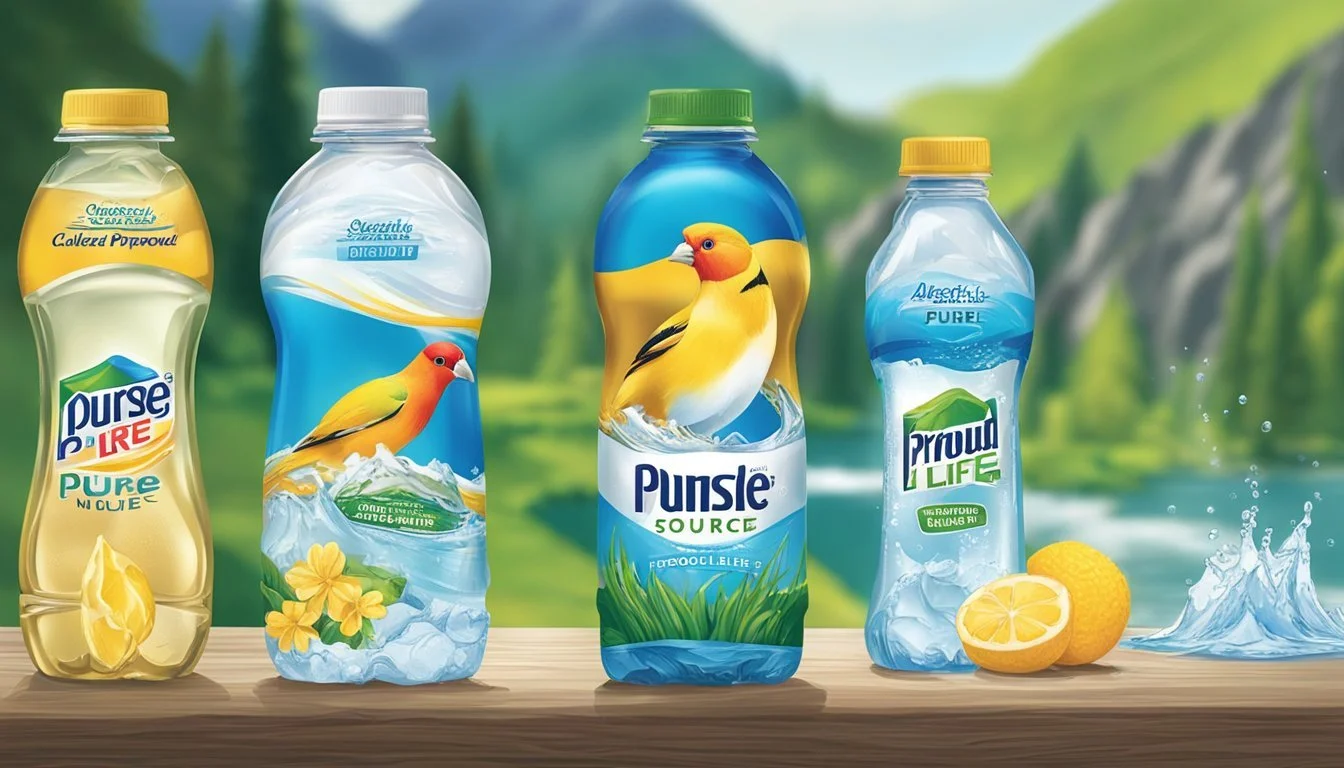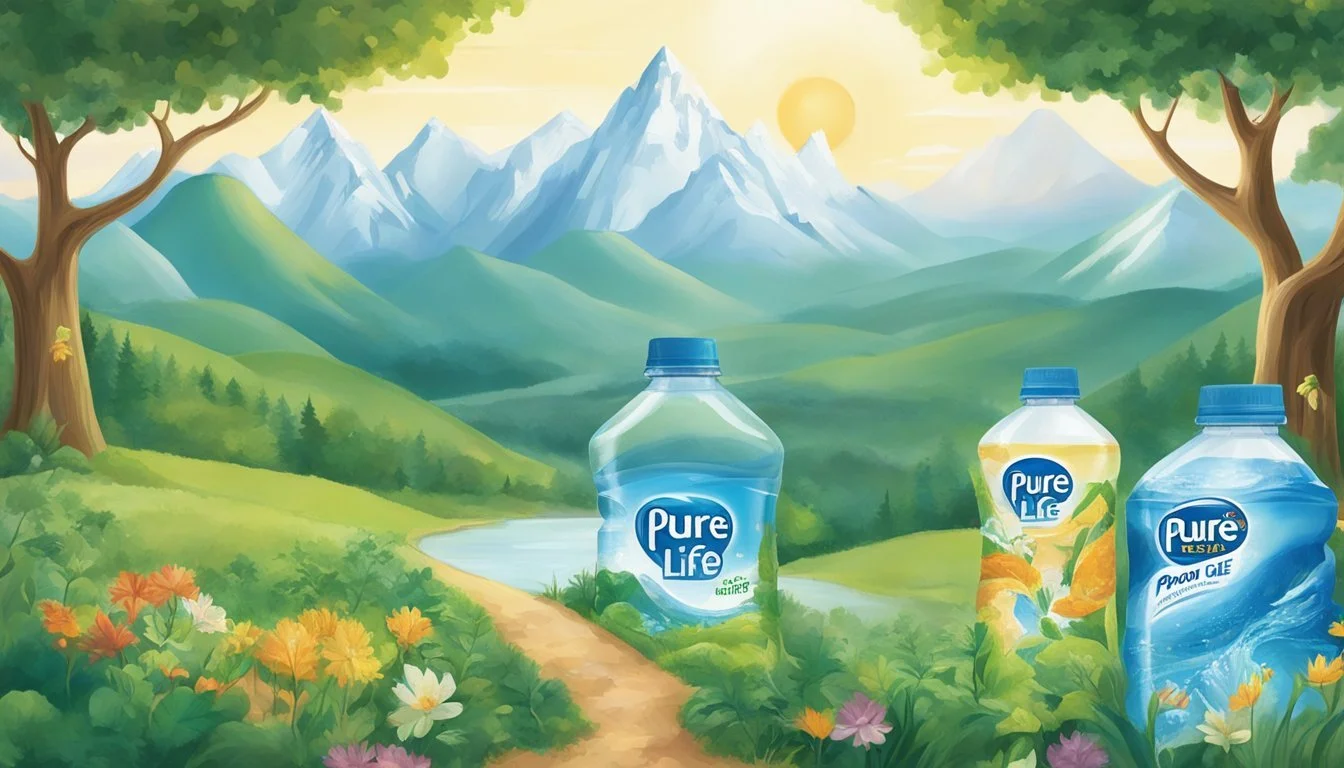Nestlé Pure Life vs. Proud Source
Ultimate Bottled Water Showdown
When choosing between Nestlé Pure Life and Proud Source, several factors come into play, including taste, quality, and brand reputation. Nestlé Pure Life is known for its widespread availability and affordability, making it a popular choice for many consumers looking for reliable hydration. With its extensive reach, Pure Life offers a consistent product that can be found almost anywhere, catering to a broad audience.
On the other hand, Proud Source positions itself as a premium brand with a focus on sourcing its water sustainably from natural springs. This brand appeals to environmentally conscious consumers who prioritize quality and purity. The taste of Proud Source water is often described as crisp and refreshing, reflecting its artisanal approach.
Ultimately, the choice between Nestlé Pure Life and Proud Source hinges on what you value more: broad accessibility and cost-effectiveness, or premium quality and sustainability. By considering what is most important to you, you can make an informed decision about which bottled water brand best meets your needs.
Background on Bottled Water Market
The bottled water market has grown significantly over the past few decades, driven by consumer demand for convenience and perceived health benefits. Trends highlight increasing competition among both legacy and niche brands.
History and Current Trends
Bottled water's popularity began soaring in the late 20th century, becoming a staple in consumer diets. Early key players like Evian and Perrier set the stage, promoting luxury and health benefits.
Recent decades have seen the entry of brands such as Fiji, Voss, and Smartwater, which market themselves on purity, taste, and unique sourcing. Premiumization and eco-conscious packaging are notable trends, with both consumers and brands prioritizing sustainability.
Major Players in the Industry
The bottled water market is dominated by major conglomerates. Nestlé Waters holds a significant share with brands like Nestlé Pure Life and Poland Spring. PepsiCo and Coca-Cola compete strongly with Aquafina and Dasani, respectively.
Luxury brands, such as Fiji and Voss, appeal to high-end consumers, while Smartwater and Evian leverage their branding around health and purity. Each player aims to meet consumer demands through innovation in packaging, source, and marketing strategies.
Understanding Water Quality and Sources
Water quality and sources play a crucial role in determining the value and health benefits of bottled water. Key considerations include the origin of the water, the minerals it contains, and the safety standards and filtration processes it undergoes.
Natural Spring Water Versus Purified Water
Natural spring water is sourced directly from an underground aquifer and is typically rich in minerals. Proud Source draws its water naturally from such springs, ensuring minimal processing to retain its natural mineral content.
On the other hand, Nestlé Pure Life primarily offers purified water. This type of water, often sourced from municipal supplies, undergoes a comprehensive filtration process, including reverse osmosis, which removes most contaminants. This makes it pure but can strip away beneficial minerals.
Mineral Content and Health Benefits
Mineral content varies significantly between spring water and purified water. Spring water like that from Proud Source tends to include a variety of essential minerals and electrolytes such as calcium, magnesium, and potassium, which can contribute to health benefits like improved bone health and electrolyte balance.
In contrast, purified water from brands such as Nestlé Pure Life might lack these minerals due to the filtration processes like reverse osmosis and distillation. Some companies add minerals back into purified water to enhance taste and health benefits, but the mineral content is often lower than that of natural spring water.
Safety Standards and Filtration Processes
Both Nestlé Pure Life and Proud Source adhere to stringent safety standards to ensure their water is safe to drink. Nestlé Pure Life utilizes advanced filtration techniques including reverse osmosis and UV treatment to eliminate contaminants, ensuring high purity levels.
Proud Source focuses on maintaining the natural purity of their spring water by employing minimal processing and natural filtration through the aquifer. This method preserves the water's natural mineral profile while meeting safety standards to keep contaminants at bay.
Each brand's approach to water quality and safety reflects their commitment to providing clean and healthy drinking water, but the processes and outcomes differ significantly.
Nestlé Pure Life: Brand Overview
Nestlé Pure Life has established itself as a prominent name in the bottled water industry. Known for its rigorous purification process and consistent quality, it has become a trusted option for clean drinking water across various regions around the world.
Production and Purification Methods
Nestlé Pure Life employs a comprehensive purification process to ensure the highest quality of water. The water undergoes multiple stages of filtration, including reverse osmosis, which removes impurities and contaminants.
This is followed by the addition of essential minerals like magnesium, calcium, and sodium to enhance taste and health benefits. Consistency in the purification process ensures that each bottle meets stringent safety standards.
The brand sources its water from multiple locations, adapting purification techniques to suit the local environment. This guarantees a clean and safe product regardless of its geographic origin.
Health and Taste Profile
Nestlé Pure Life water is designed to provide both health benefits and a pleasant taste. The added minerals, such as magnesium and calcium, contribute to the overall health profile of the water. These minerals support various bodily functions, making the water a beneficial choice for daily hydration.
The taste of Nestlé Pure Life is enhanced through its purification process. Reverse osmosis and subsequent mineral addition result in a crisp and refreshing flavor that appeals to a wide range of consumers. The brand consistently maintains a balanced pH level, which further improves the drinking experience.
Quality checks and a controlled environment ensure that every bottle of Nestlé Pure Life delivers a consistent taste, free from any off-flavors or contaminants. This reliability is a key factor in the brand's popularity among families and individuals seeking dependable, healthy hydration.
Proud Source: Brand Overview
Proud Source makes a strong argument for bottled water purity, sourcing its product from natural springs with high-quality standards and a health-focused profile.
Sourcing and Natural Spring Quality
Proud Source harvests its water from protected natural springs in the Rocky Mountains. These springs are renowned for their clean and mineral-rich waters. Proud Source emphasizes sustainability by using eco-friendly, reusable aluminum bottles rather than single-use plastics. The company's commitment is evident in their careful selection of pristine spring locations, ensuring minimal environmental impact and maintaining the water's natural purity.
Health and Taste Profile
The offered water is naturally alkaline, boasting a pH level that ranges between 7.5 and 8.5. This alkalinity contributes to a smooth, crisp taste that many find refreshing. Mineral content in Proud Source water includes essential elements such as magnesium and calcium, which contribute to its health benefits. The premium taste is free from artificial additives or sweeteners, relying instead on the natural properties of the spring water.
Packaging and Environmental Concerns
Examining the environmental impact of Nestlé Pure Life and Proud Source involves looking at their packaging choices and sustainability efforts. This analysis highlights the significance of plastic bottles, alternatives like boxed water or glass bottles, and innovative recycling solutions.
Environmental Impact of Plastic Bottles
Nestlé Pure Life bottles are predominantly made from plastic. This contributes significantly to global plastic pollution. The production and disposal of plastic bottles consume substantial oil resources and can lead to persistent environmental damage.
Plastic bottles often contain BPA, which can have adverse health effects. Moreover, even when recycling is available, only a fraction of plastic bottles ends up being recycled fully.
Microplastic particles, originating from bottles, have been found in bottled water samples worldwide, raising concerns about health impacts. Thus, the reliance on plastic bottles remains a pressing issue.
Alternatives to Plastics and Innovative Solutions
Proud Source offers an alternative with its aluminum bottles, promoting an infinitely recyclable and more environmentally friendly option compared to traditional plastics. Aluminum can be recycled repeatedly without losing quality, making it a sustainable packaging choice.
Boxed water alternatives are also gaining traction. They use recyclable paper-based cartons, reducing dependence on plastics.
Innovative solutions like biodegradable plastics and enhanced recycling technologies are being developed to address these environmental concerns. Brands that adopt these alternatives stand out in their commitment to reducing environmental impact and promoting sustainability.
Investing in environmentally friendly packaging, like glass bottles, can also help minimize pollution. Glass is fully recyclable and does not contain harmful chemicals like BPA. By prioritizing these alternatives, companies can significantly reduce their environmental footprint.
Comparing Nestlé Pure Life and Proud Source
Nestlé Pure Life and Proud Source each cater to distinct market preferences. Key points include taste, quality, price, consumer satisfaction, and availability.
Taste and Quality Comparison
Nestlé Pure Life is recognized for its neutral taste, often described as reliably consistent. The water undergoes rigorous purification processes, eliminating any off-flavors.
Proud Source sources its water from natural springs, emphasizing a crisp and refreshing taste. This brand prides itself on maintaining mineral content that enhances the water's natural flavor profile.
Price and Value for Money
Nestlé Pure Life typically offers competitive pricing due to its large-scale distribution. Consumers often find it sold in bulk, which can lower the cost per bottle.
Proud Source tends to be priced higher, reflective of its premium branding and commitment to sustainable packaging. Buyers may view this cost as justified by the perceived quality and environmental benefits.
Consumer Satisfaction and Brand Reputation
Nestlé Pure Life, as part of the global conglomerate Nestlé, benefits from wide brand recognition. It is often lauded for delivering dependable hydration across various demographics.
Proud Source enjoys a positive reputation for its commitment to sustainability and sourcing transparency. Consumers appreciate its eco-friendly efforts, which bolster the brand’s image within environmentally-conscious circles.
Convenience and Availability
Nestlé Pure Life boasts extensive availability, found in numerous retail outlets and online platforms worldwide. Its wide distribution network ensures ease of access.
Proud Source, while also available in various stores, is marketed more selectively. The brand's distribution focuses on areas where there is a demand for premium, sustainable products.
Final Thoughts on Choosing a Bottled Water
When deciding between Nestlé Pure Life and Proud Source, it's vital to consider several factors. Both brands aim to offer clean and refreshing hydration, yet they achieve this through different methods and sourcing practices.
Nestlé Pure Life is known for its purified water produced through a multi-step filtration process. This ensures a consistent taste and quality. The company emphasizes transparency about its purification standards and sources its water from various locations to meet demand.
Proud Source takes a different approach, sourcing its water from specific natural springs. This results in a balanced pH level, which many consumers find appealing. The brand prides itself on using environmentally sustainable practices, including eco-friendly packaging.
Criteria Nestlé Pure Life Proud Source Source Various Locations Natural Springs Filtration Process Multi-Step Minimal Sustainability Standard Packaging Eco-Friendly Packaging pH Balance Neutral Balanced
Some prefer the taste of spring water from Proud Source due to its natural origin. Others might appreciate the uniformity that comes from Nestlé Pure Life's rigorous filtration process.
Consumers should also consider the environmental impact. Proud Source places a strong emphasis on sustainability, which may appeal to those committed to reducing their carbon footprint.
Regardless of preference, the choice should align with personal values and quality expectations, ensuring a refreshing and reliable hydration experience.
More About Nestlé Pure Life
Acqua Panna vs Nestle Pure Life: Which Bottled Water is Better?
Aquafina vs Nestle Pure Life: Which Bottled Water is Better?
Arrowhead vs Nestle Pure Life: Which Bottled Water is Better?
Boxed Water vs Nestle Pure Life: Which Bottled Water is Better?
Core Hydration vs Nestle Pure Life: Which Bottled Water is Better?
Deer Park vs Nestle Pure Life: Which Bottled Water is Better?
Essentia vs Nestle Pure Life: Which Bottled Water is Better?
Ice Mountain vs Nestle Pure Life: Which Bottled Water is Better?
Icelandic Glacial vs Nestle Pure Life: Which Bottled Water is Better?
Just Water vs Nestle Pure Life: Which Bottled Water is Better?
Mountain Valley Spring Water vs Nestle Pure Life: Which Bottled Water is Better?
Nestle Pure Life vs 1907water: Which Bottled Water is Better?
Nestle Pure Life vs 7-Select: Which Bottled Water is Better?
Nestle Pure Life vs Alkaline88: Which Bottled Water is Better?
Nestle Pure Life vs Antipodes: Which Bottled Water is Better?
Nestle Pure Life vs Aqua Carpatica: Which Bottled Water is Better?
Nestle Pure Life vs Big Chill: Which Bottled Water is Better?
Nestle Pure Life vs BodyArmor: Which Bottled Water is Better?
Nestle Pure Life vs Cascade Mountain: Which Bottled Water is Better?
Nestle Pure Life vs Castle Rock: Which Bottled Water is Better?
Nestle Pure Life vs CBD Living: Which Bottled Water is Better?
Nestle Pure Life vs Crystal Geyser: Which Bottled Water is Better?
Nestle Pure Life vs Crystal Lake: Which Bottled Water is Better?
Nestle Pure Life vs Essence pH10: Which Bottled Water is Better?
Nestle Pure Life vs Hawaii Volcanic: Which Bottled Water is Better?
Nestle Pure Life vs Hawaiian Springs: Which Bottled Water is Better?
Nestle Pure Life vs Kirkland Signature: Which Bottled Water is Better?
Nestle Pure Life vs Liquid Death: Which Bottled Water is Better?
Nestle Pure Life vs Mananalu: Which Bottled Water is Better?
Nestle Pure Life vs Open Water: Which Bottled Water is Better?
Nestle Pure Life vs Poland Spring: Which Bottled Water is Better?
Nestle Pure Life vs Pure Life: Which Bottled Water is Better?
Nestle Pure Life vs Purely Sedona: Which Bottled Water is Better?
Nestle Pure Life vs Refreshe: Which Bottled Water is Better?
Nestle Pure Life vs Richard's Rainwater: Which Bottled Water is Better?
Nestle Pure Life vs San Pellegrino: Which Bottled Water is Better?
Nestle Pure Life vs Simple Truth: Which Bottled Water is Better?
Nestle Pure Life vs Smartwater: Which Bottled Water is Better?
Nestle Pure Life vs Solan de Cabras: Which Bottled Water is Better?
Nestle Pure Life vs Talking Rain AQA: Which Bottled Water is Better?
Nestle Pure Life vs The Well: Which Bottled Water is Better?
Nestle Pure Life vs Topo Chico: Which Bottled Water is Better?
Nestle Pure Life vs Tru Alka: Which Bottled Water is Better?
Nestle Pure Life vs Weird Water: Which Bottled Water is Better?
Nestle Pure Life vs Whole Foods 365: Which Bottled Water is Better?
Nestle Pure Life vs Whole Foods Italian Still Mineral water: Which Bottled Water is Better?
Nestle Pure Life vs Zephyrhills: Which Bottled Water is Better?
More About Proud Source
Cascade Mountain vs Pure Life: Which Bottled Water is Better?
Hawaii Volcanic vs Pure Life: Which Bottled Water is Better?
Hawaiian Springs vs Pure Life: Which Bottled Water is Better?
Icelandic Glacial vs Pure Life: Which Bottled Water is Better?
Nestle Pure Life vs Pure Life: Which Bottled Water is Better?
Pure Life vs Kirkland Signature: Which Bottled Water is Better?
Pure Life vs Whole Foods 365: Which Bottled Water is Better?
Richard's Rainwater vs Pure Life: Which Bottled Water is Better?
Solan de Cabras vs Pure Life: Which Bottled Water is Better?
Talking Rain AQA vs Pure Life: Which Bottled Water is Better?
Whole Foods Italian Still Mineral water vs Pure Life: Which Bottled Water is Better?





